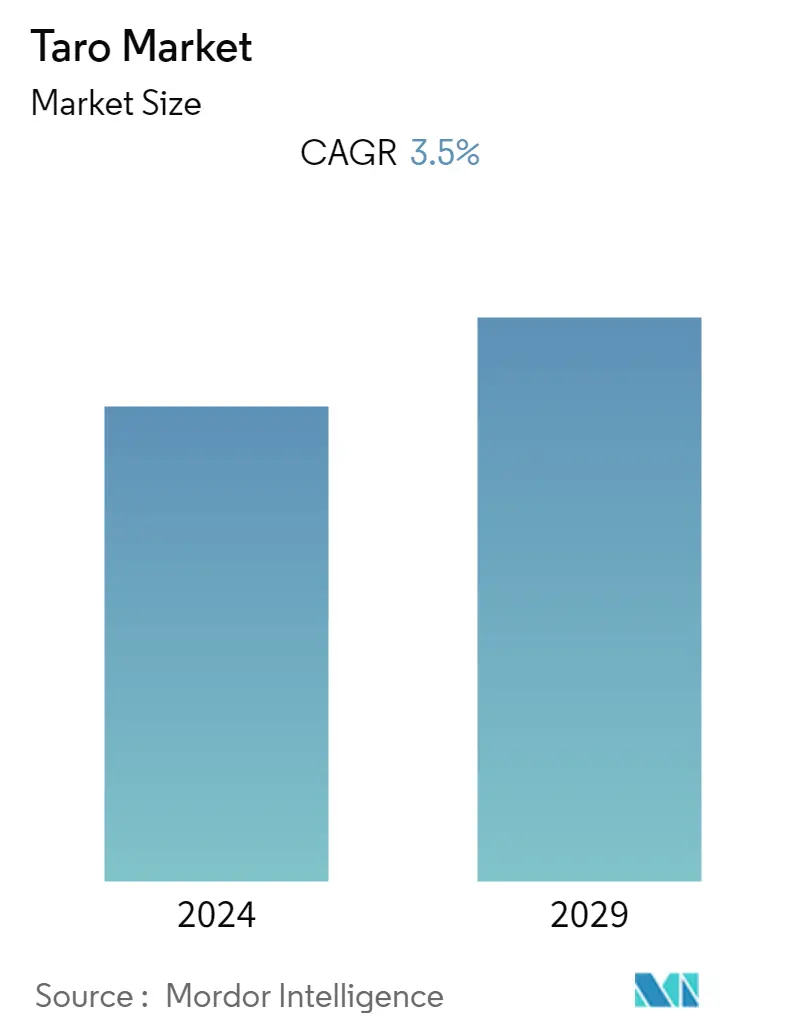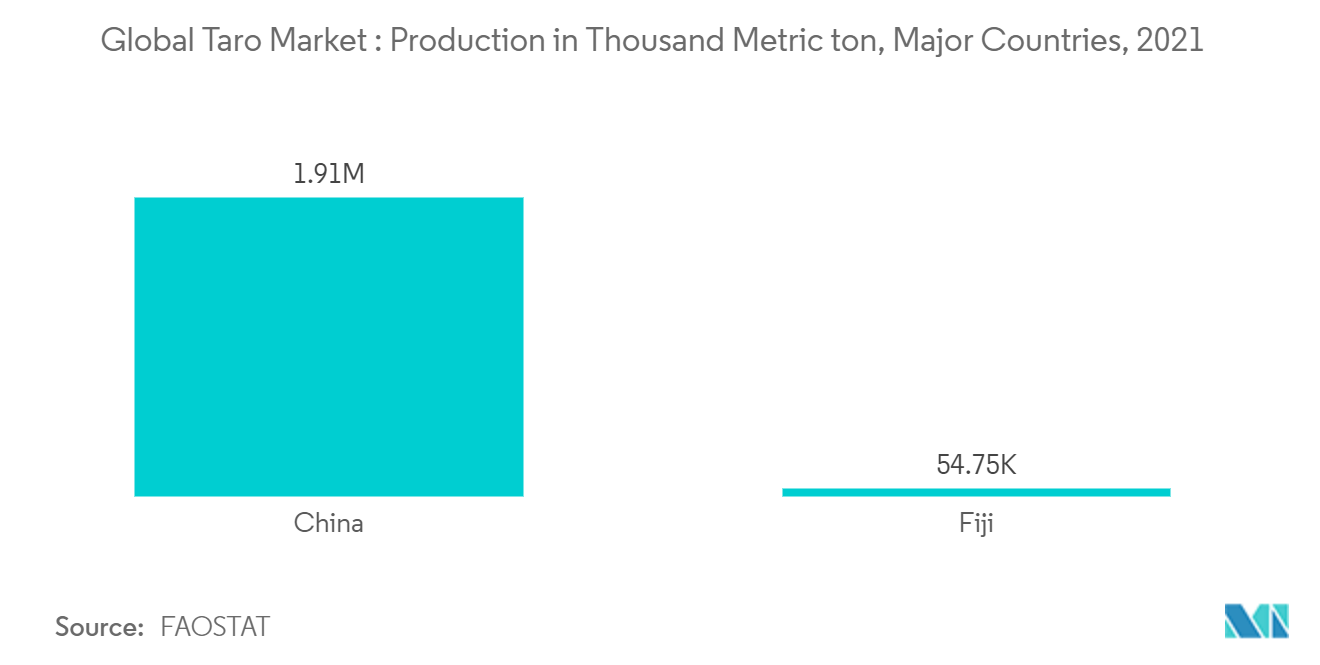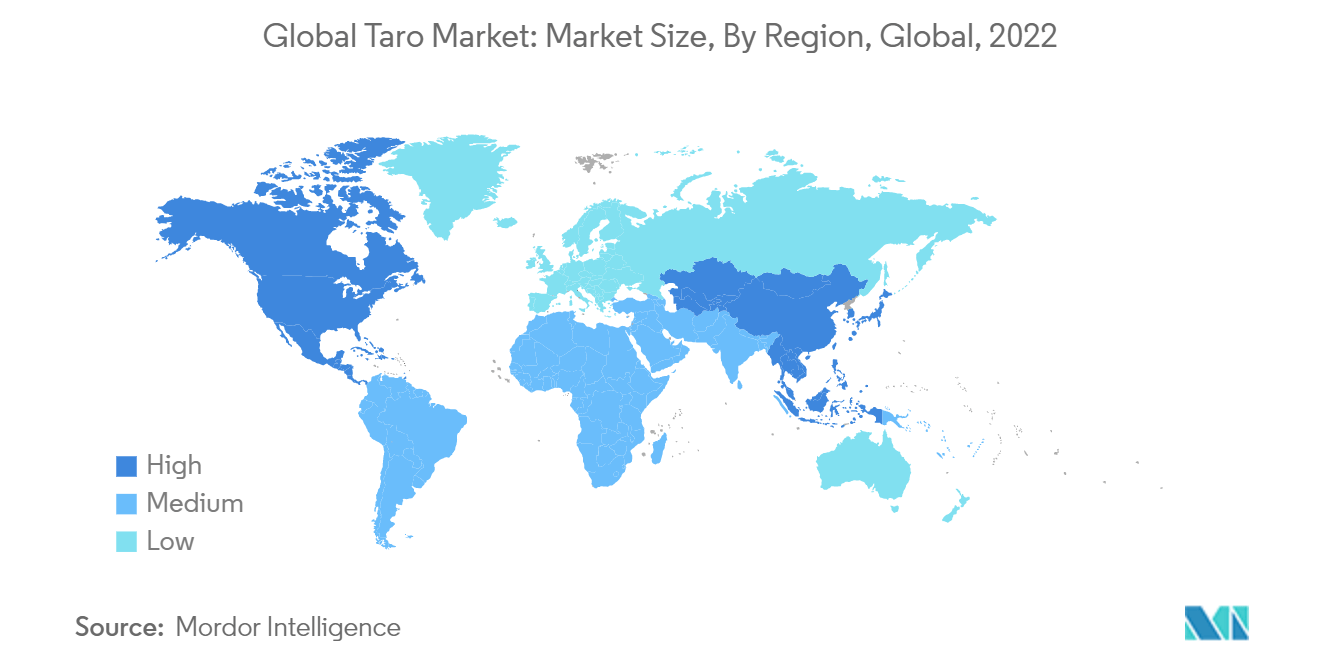Taro Market Size

| Study Period | 2019 - 2029 |
| Base Year For Estimation | 2023 |
| Forecast Data Period | 2024 - 2029 |
| CAGR | 3.50 % |
| Fastest Growing Market | Asia Pacific |
| Largest Market | North America |
Major Players*Disclaimer: Major Players sorted in no particular order |
Taro Market Analysis
The Global Taro Market is projected to register a CAGR of 3.5% during the forecast period.
- Taro (Colocasia esculenta) is rich in carbohydrates and a good replacement for wheat flour. However, it is well-known to farmers for its ability to produce a reasonable yield in poor soil conditions with less or no farm inputs and often grown by resource-limited farmers, and is regarded as a good source of food security. Taro powder is also becoming popular, and this will boost the growth of the market in the coming years.
- Taro is the most widely cultivated species in the family Araceae, which is used as a vegetable. Countries such as the United States, Australia, Japan, and New Zealand are the key import market. Major producing countries are China, Ecuador, Costa Rica, Fiji, and Indonesia.
- Globally, North America is dominating taro imports. For instance, in 2021, the United States imported 35.7% of the total taro imports. Rising demand from North America and Asia-Pacific countries is driving taro production. In 2021, taro production was 12.3 million tons. This was which is slightly declined compared to the previous year's production which is 12.6 million metric ton due to the pandemic effect in the world.
Taro Market Trends
Strong Growth in Taro Production
Taro is a great source of carbohydrate used in infant weaning diets and low glycaemic index foods suitable for diabetics. Its tuber has starch molecules which are smaller than those of potato, corn and wheat and can be used in cosmetics and in pharmaceuticals as binders in tablets. Both corms and leaves contain good-quality protein and are good sources of phosphorus, potassium, calcium, and readily available iron. Moreover, the starch in taro's tuber has the capacity to end the world's plastic menace and it can be used to make plastic that degenerates over time. Due to its nutritional benefit and other industrial, the demand for the taro is increasing across the globe. To satisfy the rising demand, farmers are increasing the area cultivated under taro.
According to FAOSTAT, taro production was 12.3 million ton which slightly declined compared to the previous year's production which is 12.6 million metric ton due to the pandemic effect in the world. During the same year, nearly 86.3% of global production was dominated by major producing countries such as China, Ecuador, Costa Rica, Fiji, and Indonesia in which China showed the highest production value compared to all countries with 1.9 million metric ton followed by Fiji. This will boost the taro market in the Asia region during the forecasting period.

North America Dominates the Global Imports
North America is the largest market for Taro which dominates globally due to the high consumer demand. In restaurants, Taro root is most commonly used to make chips and is a healthier alternative to corn or potato chips. According to ITC Trade, in 2021, Global import value was valued at USD 181,258 thousand, which increased by 21% compared to 2020. In 2021, the United States and Canada were among the major importing countries, and the United States is the largest importer of taro in the North American region.
In 2021, the United States imported taros worth USD 64,674 thousand, depicting 35.9% of the global imports. Ecuador, Mexico, and Costa Rica are the major exporting countries to the United States. According to ITC Trade, in 2021, Ecuador exported USD 35,309 thousand worth of taros to the United States, Mexico exported USD 9,021 thousand worth of taros, and the exports from Costa Rica were valued at USD 7,336 thousand.
Moreover, the high nutritional value of cocoyam could be explored in new markets in Europe and the United States of America to substitute for other vegetables, such as spinach. This is expected to lead to the market growth over the forecast period.

Taro Market News
- January 2023: BobaBam launched new Milk Tea and Taro, which features two of the Los Angeles-based company's newest flavors which are among the best-selling flavors at boba shops around 200 club locations across the Northeast and West Coast. The new variety pack contains 14 packs (7 each of Milk Tea and Taro) and includes eco-friendly packaging.
- March 2022: A super-sized taro root was harvested on Hawaii's Big Island. According to the US Department of Agriculture, taro plants usually weigh between 1 and 2 lbs., but the 50-pound corm, which is the root of a taro plant, was grown on Ahiu Farm in Hawaii Island's South Kona and could possibly be the largest on record.
Taro Market Report - Table of Contents
1. INTRODUCTION
- 1.1 Study Assumptions & Market Definitions
- 1.2 Scope of the Study
2. RESEARCH METHODOLOGY
3. EXECUTIVE SUMMARY
4. MARKET DYNAMICS
- 4.1 Market Overview
- 4.2 Market Drivers
- 4.3 Market Restraints
- 4.4 Value Chain Analysis
5. MARKET SEGMENTATION
-
5.1 Geography
- 5.1.1 North America
- 5.1.1.1 United States
- 5.1.1.1.1 Production Analysis
- 5.1.1.1.2 Consumption Analysis and Market Value
- 5.1.1.1.3 Import Market Analysis (Volume and Value)
- 5.1.1.1.4 Export Market Analysis (Volume and Value)
- 5.1.1.1.5 Price Trend Analysis
- 5.1.1.2 Canada
- 5.1.1.2.1 Production Analysis
- 5.1.1.2.2 Consumption Analysis and Market Value
- 5.1.1.2.3 Import Market Analysis (Volume and Value)
- 5.1.1.2.4 Export Market Analysis (Volume and Value)
- 5.1.1.2.5 Price Trend Analysis
- 5.1.2 Europe
- 5.1.2.1 France
- 5.1.2.1.1 Production Analysis
- 5.1.2.1.2 Consumption Analysis and Market Value
- 5.1.2.1.3 Import Market Analysis (Volume and Value)
- 5.1.2.1.4 Export Market Analysis (Volume and Value)
- 5.1.2.1.5 Price Trend Analysis
- 5.1.2.2 Germany
- 5.1.2.2.1 Production Analysis
- 5.1.2.2.2 Consumption Analysis and Market Value
- 5.1.2.2.3 Import Market Analysis (Volume and Value)
- 5.1.2.2.4 Export Market Analysis (Volume and Value)
- 5.1.2.2.5 Price Trend Analysis
- 5.1.2.3 Poland
- 5.1.2.3.1 Production Analysis
- 5.1.2.3.2 Consumption Analysis and Market Value
- 5.1.2.3.3 Import Market Analysis (Volume and Value)
- 5.1.2.3.4 Export Market Analysis (Volume and Value)
- 5.1.2.3.5 Price Trend Analysis
- 5.1.2.4 Russia
- 5.1.2.4.1 Production Analysis
- 5.1.2.4.2 Consumption Analysis and Market Value
- 5.1.2.4.3 Import Market Analysis (Volume and Value)
- 5.1.2.4.4 Export Market Analysis (Volume and Value)
- 5.1.2.4.5 Price Trend Analysis
- 5.1.2.5 Chile
- 5.1.2.5.1 Production Analysis
- 5.1.2.5.2 Consumption Analysis and Market Value
- 5.1.2.5.3 Import Market Analysis (Volume and Value)
- 5.1.2.5.4 Export Market Analysis (Volume and Value)
- 5.1.2.5.5 Price Trend Analysis
- 5.1.3 Asia-Pacific
- 5.1.3.1 China
- 5.1.3.1.1 Production Analysis
- 5.1.3.1.2 Consumption Analysis and Market Value
- 5.1.3.1.3 Import Market Analysis (Volume and Value)
- 5.1.3.1.4 Export Market Analysis (Volume and Value)
- 5.1.3.1.5 Price Trend Analysis
- 5.1.3.2 Japan
- 5.1.3.2.1 Production Analysis
- 5.1.3.2.2 Consumption Analysis and Market Value
- 5.1.3.2.3 Import Market Analysis (Volume and Value)
- 5.1.3.2.4 Export Market Analysis (Volume and Value)
- 5.1.3.2.5 Price Trend Analysis
- 5.1.3.3 Malaysia
- 5.1.3.3.1 Production Analysis
- 5.1.3.3.2 Consumption Analysis and Market Value
- 5.1.3.3.3 Import Market Analysis (Volume and Value)
- 5.1.3.3.4 Export Market Analysis (Volume and Value)
- 5.1.3.3.5 Price Trend Analysis
- 5.1.3.4 Australia
- 5.1.3.4.1 Production Analysis
- 5.1.3.4.2 Consumption Analysis and Market Value
- 5.1.3.4.3 Import Market Analysis (Volume and Value)
- 5.1.3.4.4 Export Market Analysis (Volume and Value)
- 5.1.3.4.5 Price Trend Analysis
- 5.1.3.5 India
- 5.1.3.5.1 Production Analysis
- 5.1.3.5.2 Consumption Analysis and Market Value
- 5.1.3.5.3 Import Market Analysis (Volume and Value)
- 5.1.3.5.4 Export Market Analysis (Volume and Value)
- 5.1.3.5.5 Price Trend Analysis
- 5.1.4 South America
- 5.1.4.1 Brazil
- 5.1.4.1.1 Production Analysis
- 5.1.4.1.2 Consumption Analysis and Market Value
- 5.1.4.1.3 Import Market Analysis (Volume and Value)
- 5.1.4.1.4 Export Market Analysis (Volume and Value)
- 5.1.4.1.5 Price Trend Analysis
- 5.1.4.2 Argentina
- 5.1.4.2.1 Production Analysis
- 5.1.4.2.2 Consumption Analysis and Market Value
- 5.1.4.2.3 Import Market Analysis (Volume and Value)
- 5.1.4.2.4 Export Market Analysis (Volume and Value)
- 5.1.4.2.5 Price Trend Analysis
- 5.1.5 Middle East And Africa
- 5.1.5.1 Turkey
- 5.1.5.1.1 Production Analysis
- 5.1.5.1.2 Consumption Analysis and Market Value
- 5.1.5.1.3 Import Market Analysis (Volume and Value)
- 5.1.5.1.4 Export Market Analysis (Volume and Value)
- 5.1.5.1.5 Price Trend Analysis
- 5.1.5.2 South Africa
- 5.1.5.2.1 Production Analysis
- 5.1.5.2.2 Consumption Analysis and Market Value
- 5.1.5.2.3 Import Market Analysis (Volume and Value)
- 5.1.5.2.4 Export Market Analysis (Volume and Value)
- 5.1.5.2.5 Price Trend Analysis
6. MARKET OPPORTUNITIES AND FUTURE TRENDS
** Subject To AvailablityTaro Industry Segmentation
Taro or Coco yam is a common name for the corms and tubers of several plants in the Araceae family. Of these, Colocasia esculenta (L.) Schott, commonly known as dasheen and eddo, is the most widely cultivated. For the purpose of the report, taro is defined as one of the edible aroids distributed throughout the world, particularly in tropical regions. The Taro Market is Segmented by Geography (North America, Europe, Asia-Pacific, Middle-East, and Africa). The study includes Production Analysis (Volume), Consumption Analysis (Value and Volume), Export Analysis (Value and Volume), Import Analysis (Value and Volume), and Price Trend Analysis. The report offers the market size and forecast in both value (USD million) and volume (metric ton).
| Geography | North America | United States | Production Analysis |
| Consumption Analysis and Market Value | |||
| Import Market Analysis (Volume and Value) | |||
| Export Market Analysis (Volume and Value) | |||
| Price Trend Analysis | |||
| Geography | North America | Canada | Production Analysis |
| Consumption Analysis and Market Value | |||
| Import Market Analysis (Volume and Value) | |||
| Export Market Analysis (Volume and Value) | |||
| Price Trend Analysis | |||
| Geography | Europe | France | Production Analysis |
| Consumption Analysis and Market Value | |||
| Import Market Analysis (Volume and Value) | |||
| Export Market Analysis (Volume and Value) | |||
| Price Trend Analysis | |||
| Geography | Europe | Germany | Production Analysis |
| Consumption Analysis and Market Value | |||
| Import Market Analysis (Volume and Value) | |||
| Export Market Analysis (Volume and Value) | |||
| Price Trend Analysis | |||
| Geography | Europe | Poland | Production Analysis |
| Consumption Analysis and Market Value | |||
| Import Market Analysis (Volume and Value) | |||
| Export Market Analysis (Volume and Value) | |||
| Price Trend Analysis | |||
| Geography | Europe | Russia | Production Analysis |
| Consumption Analysis and Market Value | |||
| Import Market Analysis (Volume and Value) | |||
| Export Market Analysis (Volume and Value) | |||
| Price Trend Analysis | |||
| Geography | Europe | Chile | Production Analysis |
| Consumption Analysis and Market Value | |||
| Import Market Analysis (Volume and Value) | |||
| Export Market Analysis (Volume and Value) | |||
| Price Trend Analysis | |||
| Geography | Asia-Pacific | China | Production Analysis |
| Consumption Analysis and Market Value | |||
| Import Market Analysis (Volume and Value) | |||
| Export Market Analysis (Volume and Value) | |||
| Price Trend Analysis | |||
| Geography | Asia-Pacific | Japan | Production Analysis |
| Consumption Analysis and Market Value | |||
| Import Market Analysis (Volume and Value) | |||
| Export Market Analysis (Volume and Value) | |||
| Price Trend Analysis | |||
| Geography | Asia-Pacific | Malaysia | Production Analysis |
| Consumption Analysis and Market Value | |||
| Import Market Analysis (Volume and Value) | |||
| Export Market Analysis (Volume and Value) | |||
| Price Trend Analysis | |||
| Geography | Asia-Pacific | Australia | Production Analysis |
| Consumption Analysis and Market Value | |||
| Import Market Analysis (Volume and Value) | |||
| Export Market Analysis (Volume and Value) | |||
| Price Trend Analysis | |||
| Geography | Asia-Pacific | India | Production Analysis |
| Consumption Analysis and Market Value | |||
| Import Market Analysis (Volume and Value) | |||
| Export Market Analysis (Volume and Value) | |||
| Price Trend Analysis | |||
| Geography | South America | Brazil | Production Analysis |
| Consumption Analysis and Market Value | |||
| Import Market Analysis (Volume and Value) | |||
| Export Market Analysis (Volume and Value) | |||
| Price Trend Analysis | |||
| Geography | South America | Argentina | Production Analysis |
| Consumption Analysis and Market Value | |||
| Import Market Analysis (Volume and Value) | |||
| Export Market Analysis (Volume and Value) | |||
| Price Trend Analysis | |||
| Geography | Middle East And Africa | Turkey | Production Analysis |
| Consumption Analysis and Market Value | |||
| Import Market Analysis (Volume and Value) | |||
| Export Market Analysis (Volume and Value) | |||
| Price Trend Analysis | |||
| Geography | Middle East And Africa | South Africa | Production Analysis |
| Consumption Analysis and Market Value | |||
| Import Market Analysis (Volume and Value) | |||
| Export Market Analysis (Volume and Value) | |||
| Price Trend Analysis |
Taro Market Research FAQs
What is the current Taro Market size?
The Taro Market is projected to register a CAGR of 3.5% during the forecast period (2024-2029)
Which is the fastest growing region in Taro Market?
Asia Pacific is estimated to grow at the highest CAGR over the forecast period (2024-2029).
Which region has the biggest share in Taro Market?
In 2024, the North America accounts for the largest market share in Taro Market.
What years does this Taro Market cover?
The report covers the Taro Market historical market size for years: 2019, 2020, 2021, 2022 and 2023. The report also forecasts the Taro Market size for years: 2024, 2025, 2026, 2027, 2028 and 2029.
Taro Industry Report
Statistics for the 2024 Taro market share, size and revenue growth rate, created by Mordor Intelligence™ Industry Reports. Taro analysis includes a market forecast outlook to 2029 and historical overview. Get a sample of this industry analysis as a free report PDF download.



